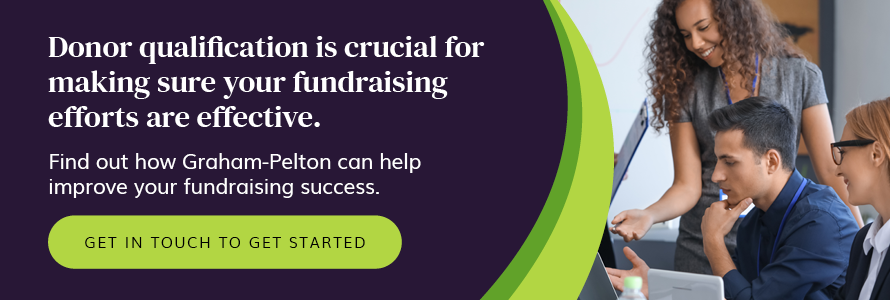
If you have worked in development for at least one week, you’ve probably been encouraged to find new donors – an edict coming either from your leadership, a board member, or a colleague. Every organization seeks new donors as a way to grow and diversify its funding streams. The strongest action you can take to reach these goals is to focus on donor qualification.
As many gift officers know, qualification can be a development department’s four-letter word. Qualification gets a bad rap – it’s a process that seems really easy but can actually be quite challenging, especially if organizations don’t have the structures or volunteers in place to facilitate a smooth qualification process. To ease this process, we’ll be covering some helpful tips to better integrate donor qualification into your moves management processes:
Donor qualification can help elevate your donor stewardship and greatly improve your moves management as you get to know donors better. The topics we cover in this guide will help you reap all of the benefits of excellent donor qualification.
What Is Donor Qualification? FAQ
Donor qualification is the process by which you determine whether or not a donor is someone you should spend time building a personal relationship with. While you are already determining prospective donors who meet your major gift criteria through prospect research, donor qualification helps you to further identify donors who not only meet your criteria but are also interested in a personal connection and relationship with your organization.
Qualification also helps you preserve your limited time and resources while boosting overall development ROI by focusing on those most likely to develop impactful relationships with you. Ultimately, it allows you to quickly prioritize your development efforts to maximize impact.
How does donor qualification work?
Donor qualification typically involves personal conversations with donors to further learn about them and develop your relationship. These conversations usually consist of the major gift officer asking lots of questions and getting to know the donor better.
Rather than being a meeting where you’re aiming to cinch a major gift by the end, donor qualification meetings are small steps taken over time that build genuine relationships with donors. They should not be rushed or transactional.
When should you perform donor qualification?
Donor qualification should be done before soliciting major gifts from donors, but ideally, it will be a standard part of every step along the way. Because donor qualification is the act of developing a relationship, it is not a one-and-done task. This is why we recommend implementing donor qualification as part of your ongoing moves management for the most success.
What is moves management and why is it relevant?
Moves management refers to the management of all the individual steps, or “moves,” in the donor engagement process. Moves management is a structure that guides engagement by outlining goals for each step and determining what the next step should be. This process helps you better identify the right moment to make an ask.
Because donor qualification is an essential part of the donor engagement cycle, it should be built into your moves management process. However, instead of giving it its own step, it can actually be more beneficial to simply infuse donor qualification into all of your steps. This is because ongoing conversations help you continuously learn more and improve engagement, not to mention how it helps build the relationship more authentically over time when it’s integrated into all of your steps.

3 Steps to Incorporate Donor Qualification Into Moves Management
Initial donor qualification can be a lot like online dating: it involves cold calling, is a test of endurance, and is often met with rejection. I would venture to say it’s the most misunderstood part of the moves management process and viewed with trepidation if not outright derision by those tasked with the pursuit.
Why? Largely because development officers think it’s the first thing you must accomplish with a prospective donor. And while it is the first step to a positive donor relationship, it’s not the only time a prospect or donor should be qualified.
One way to positively embrace qualification is to make it part of every step of your moves management process. If it’s not, you’re not learning or asking questions, and you may be missing opportunities with your donors. After all, what is the ultimate goal of qualification? The answer: To determine whether or not a donor wants to move forward – and that is invaluable information to know at every stage of moves management.
So, how do we start incorporating qualification into all stages of the moves management cycle, and not just at its start?
1. Revise your assumptions and re-qualify your donors.
People’s lives, interests, and priorities are constantly changing. That’s why you need to re-qualify your donors on a regular basis. If you’ve launched a new program or pivoted since 2020, don’t assume your donor is reading the newsletter you’re sending out or isn’t interested in hearing about that niche opportunity to make an impact.
Every conversation should have a goal, and as a development professional, you should learn something new after every conversation. Continue engaging your board, and ask your donors questions. Your qualification questions will certainly look and feel different during this stewardship period than they did when you first identified the donor, but they remain an important part of the moves management process and should remain a critical part of your efforts.
Remember, you are qualifying the prospect for the next phase in the development relationship. For a prospect in stewardship, you might be qualifying them for the next gift, or for a different type of gift. (Don’t forget planned giving opportunities!)
2. Incorporate research into the moves management cycle.
Don’t just complete research in advance of a solicitation. There are easy steps anyone can take to complete 10-minute qualification research in advance of your first meeting. And don’t wait around for your team’s prospect researcher to do all the research work. You can help and contribute to the process too! Here are just three examples:
- Where do they work? While many businesses have suffered, many have thrived during the last year.
- Do they hold any stock? Have they recently sold stock or bought new stock?
- Do they sit on any boards? It is oftentimes easy to determine if they’re connected to other nonprofits or companies.
As you then approach a planned solicitation, perhaps that is the time that you complete a more comprehensive profile. After you’ve been in contact with a donor for 12-18 months, it’s time to revisit the qualification research you did initially. Have they made new gifts? Did they buy and sell stock? Have they moved? Research can help you validate assumptions, and it can also provide you with important data points you may not be able to learn in a casual conversation. Wealth screening providers such as iWave, DonorSearch, Blackbaud’s ResearchPoint, and WealthEngine can help expedite the process. But don’t hesitate to do your own Google searches to see what else you can find!
3. Continue to embrace technology and virtual visits.
Some people are feeling Zoom fatigue – but many aren’t. And it’s up to you to find out how your organization’s supporters feel. In this case, technology is most certainly your friend! How many visits does it normally take to be invited to your donor’s home? A “home visit,” via a computer screen, is now the norm.
Virtual visits tee you up for efficient and effective donor qualification.
Many people, especially early in their careers, view qualification as a drag, bore, and a number of other four-letter words. Yet, your perspective may change dramatically when you view it through a new lens:
First, qualification is the act of asking questions. Plain and simple. Thus, not only is it easier to incorporate qualification into your own portfolio management, but also to reframe the task for leadership, board members, and colleagues.
Second, don’t expect qualification to achieve some big goal or outcome. Instead, think of it as the small steps you take that, over time, result in a long journey.
Third, partner with your research and prospect management teams. Remember that the onus is not just on your researcher to find new prospects or qualify donors. Just like qualification, your relationship with your research colleagues (if you’re lucky to have that support!) should be consistent and ongoing.
Wrapping Up
As you move donors through your cultivation and stewardship cycle, getting to know them through donor qualification will be essential for increasing donor affinity for your organization. These relationships not only genuinely improve your nonprofit’s donor relationships and reputation but also increase your chances of securing major gifts from donors who feel connected. Remember — qualification should be an ongoing process that’s integrated into your broader moves management strategy. The value of continually learning more about your prospects and donors as individuals can’t be understated.
To learn more about nonprofit development best practices, explore these additional resources from the Graham-Pelton team:
- Grateful Patient Fundraising: 5 Best Practices for Success. Donor qualification is just one of the best practices to keep in mind if you’re fundraising for a hospital or similar institution.
- Prospect Portfolio Management: The 3-Step Strategy You Need. Managing your prospects with a portfolio system gives your development team the structure they need to succeed.
- Conducting a Capital Campaign Feasibility Study: 5 Steps. Planning a capital campaign? Learn how and why to test your plans with a feasibility study.
- Building a Case for Support That Inspires Action: 5 Steps. Every nonprofit can benefit from developing a compelling case for support for general or campaign-specific use.
- Employee Retention Strategies for Nonprofits: Complete Guide. Retaining your organization’s employees is key to having the capacity to accomplish your mission.





